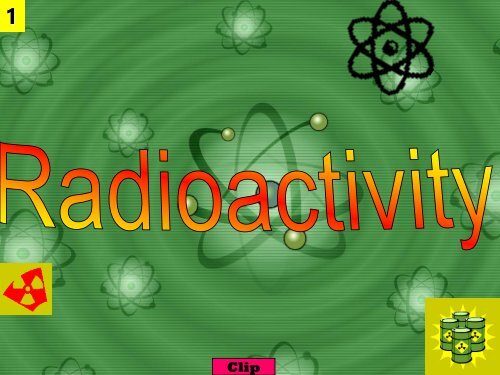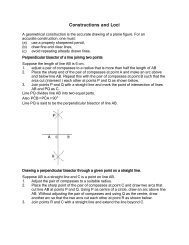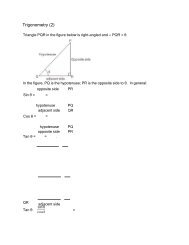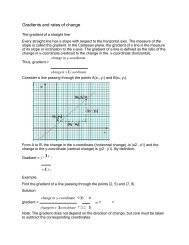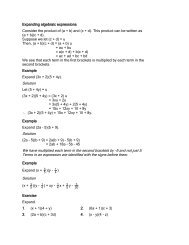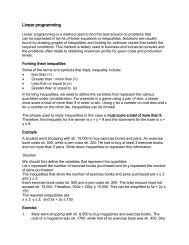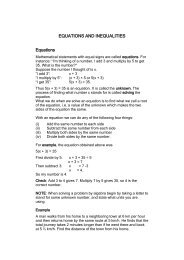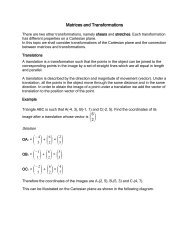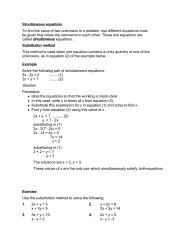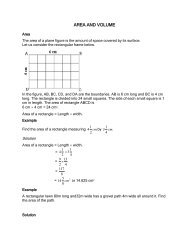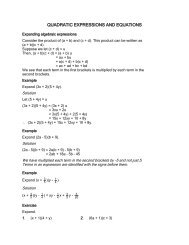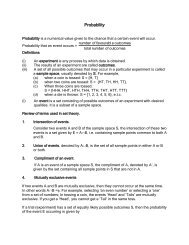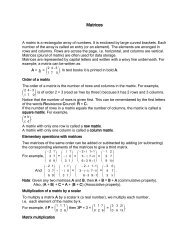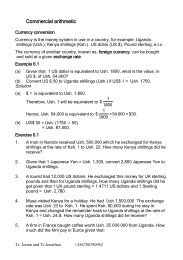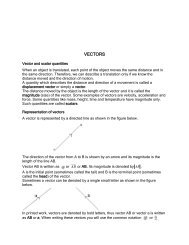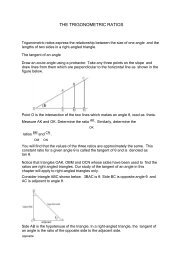ph35
Create successful ePaper yourself
Turn your PDF publications into a flip-book with our unique Google optimized e-Paper software.
1<br />
Clip
2<br />
1 . Differentiate among alpha and<br />
beta particles and gamma radiation .<br />
2 . Differentiate between fission and<br />
fusion .<br />
3 . Explain the process half-life as<br />
related to radioactive decay .<br />
4. Describe nuclear energy , its<br />
practical application as an alternative<br />
energy source , and its potential<br />
problems.
3<br />
Clip<br />
Radioactivity is the spontaneous<br />
disintegration of atomic nuclei. The<br />
nucleus emits α particles, ß<br />
particles, or electromagnetic rays<br />
during this process.<br />
After decaying, radioactive atoms<br />
“change” into other atoms
4<br />
• Why does the atom do this?<br />
– the nucleus of an atom attempts to become<br />
more stable<br />
• In some instances, a new element is<br />
formed and in other cases, a new form<br />
of the original element, called an<br />
isotope, appears.<br />
– this process of change is often referred to as<br />
the decay of atoms.<br />
• The rate of Radioactive decay is<br />
described in half-lives.
5<br />
Energy is released during<br />
radioactive decay
TED ed: Radioactivity: Expect the Unexpected
6<br />
Types of Nuclear<br />
Radiation<br />
• When an unstable<br />
nucleus decays,<br />
particles and energy<br />
are given off from the<br />
decaying nucleus.<br />
• α and β radiation is in<br />
the form of particles<br />
• γ radiation is in the<br />
form of waves-kind of<br />
like light but higher<br />
frequency
7<br />
Nuclear Decay<br />
2 protons & 2 neutrons<br />
Neutron decays into a proton<br />
& an electron is given off<br />
Only Energy is release
• 8 Alpha particles consist of two protons and two<br />
neutrons, identical to the nucleus of a helium<br />
atom.<br />
• A sheet of paper or a person’s surface layer of<br />
skin will stop them.<br />
• Alpha particles are only considered hazardous to<br />
a person’s health if they are ingested or inhaled<br />
and thus come into contact with sensitive cells<br />
such as in the lungs, liver and bones.
Examples of Alpha Decay
• Beta particles are electrons emitted from the nuclei<br />
of many fission products.<br />
10<br />
•They can travel a few<br />
feet in air but can usually<br />
be stopped by clothing or<br />
a few centimeters of<br />
wood.<br />
•They are considered<br />
hazardous mainly if<br />
ingested or inhaled, but<br />
can cause radiation<br />
damage to the skin if the<br />
exposure is large enough.<br />
•Unstable Neutron decays<br />
into a proton.
Examples of Beta Decay<br />
Beta Decay<br />
with<br />
Gamma<br />
Radiation
11
• Gamma rays are a form of electromagnetic<br />
radiation (like light, radio, and television) that<br />
come from the nucleus of a radioactive atom.<br />
– Occurs when an unstable nucleus emits electromagnetic<br />
radiation. The radiation has no mass, and so its emission<br />
does not change the element.<br />
– They penetrate matter easily and are best stopped by<br />
water or thick layers of lead or concrete.<br />
– Gamma radiation is hazardous to people inside and outside<br />
of the body.<br />
•However, gamma radiation often accompanies alpha and<br />
beta emission, which do change the element's identity.<br />
•Gamma rays have the lowest ionizing power, but the highest<br />
penetrating power.<br />
12
Gamma Radiation
13
14<br />
Biological Effects of Radiation:<br />
Ionizing radiation causes physical<br />
damage to cells and DNA.<br />
Radiation can excite DNA and result<br />
in the destruction on the DNA<br />
backbone.<br />
At high doses of radiation (10,000 -<br />
15,000 rads), death occurs in a few<br />
hours because of neurological and<br />
cardiovascular breakdown (Central<br />
Nervous Syndrome).
14<br />
Biological Effects of Radiation:<br />
Medium doses, 500 - 1200 rads,<br />
causes death to occur in a few days<br />
because of the destruction of the<br />
gastrointestinal mucosa.<br />
Lower doses, 250 - 500 rads,<br />
causes death to occur after several<br />
weeks due to damage of the blood<br />
forming organs (hematopoietic<br />
syndrome).
Radiation is used positively in a variety of ways 15<br />
Medicine<br />
•For example, radiation and radioactive<br />
tracers are used to diagnose and treat medical<br />
problems.<br />
•A radioactive tracer is a radioactive isotope<br />
that is added to a substance so that the<br />
substance can be detected later.<br />
•Radioactive tracers are used to locate tumors, to<br />
study the functioning of a particular organ, or to<br />
monitor the flow of blood.<br />
•For example, radioactive iodine-131 is used<br />
to diagnose thyroid problems.<br />
•Radiation therapy used to treat cancer may<br />
involve the use of implanted radioactive isotopes such as<br />
gold-198 or iridium-192.
Industry<br />
•Manufacturers can also use radiation to<br />
check the thickness of metal<br />
containers by measuring the amount of<br />
radiation that passes through.<br />
•Small amounts of radioactive isotopes,<br />
like magnesium-28, can be introduced in a<br />
water source to determine the flow of<br />
underground water or to determine if an<br />
underground water system is leaking.<br />
•Radioactive isotopes are even used in<br />
smoke alarms.<br />
16
17<br />
Generate electrical power<br />
Nuclear fission is used to generate<br />
electricity as an alternative energy<br />
source.<br />
Dating- finding the age<br />
Even the age of fossils or rocks can<br />
be determined by using radioactive<br />
isotopes.
18<br />
Fission and Fusion<br />
Fission<br />
Fusion<br />
Splitting a nucleus<br />
Combining of two nuclei.
•Nuclear power can<br />
come from the fission<br />
of uranium, plutonium<br />
or thorium or the fusion<br />
of hydrogen into<br />
helium.<br />
•Today it is almost all<br />
uranium.<br />
•The fission of an atom<br />
of uranium produces 10<br />
million times the energy<br />
produced by the<br />
combustion of an atom<br />
of carbon from coal.<br />
•Chain Reaction video<br />
19
20<br />
Issues for Fission Power Plants<br />
Clip<br />
•Need for a spent fuel disposal facility<br />
and a decommissioning plan<br />
•Use of large amounts of water for<br />
cooling purposes (if wet cooling towers<br />
are used) –thermal pollution<br />
•Biological impacts on the ocean due to<br />
thermal discharge (if seawater cooling is<br />
used)<br />
•Public safety concerns<br />
Bill Nye Clip
21<br />
FUSION<br />
•Fusion reaction: occurs when nuclei of light elements<br />
are forced together at extremely high temperatures<br />
until they fuse into nuclei of heavier elements and<br />
release enormous amounts of energy.<br />
•Issues: The fuel must be heated in the form of<br />
plasma (a highly ionized gas) to a very high<br />
temperature.
Identify each type of reaction…alpha, beta, gamma, fusion or<br />
fission...write your answers below your crossword on the ½ sheet.<br />
1.<br />
2.<br />
3.<br />
4.<br />
5.
22<br />
Half Life is the amount of time it takes<br />
for half of the nuclei in a sample to decay<br />
Bill Nye Explains Half Life<br />
Mass<br />
(kg)
12<br />
C<br />
14<br />
C<br />
mass number<br />
13<br />
C<br />
• Carbon occurs naturally in three<br />
isotopes.<br />
• All of these atoms have the same<br />
number of protons but different<br />
numbers of neutrons.<br />
• The number of neutrons and protons<br />
determines the mass, so the masses<br />
are different.<br />
• 14 C is radioactive.
14<br />
C<br />
• Radioactive 14 C acts chemically just like<br />
12<br />
C, so it becomes incorporated into plants<br />
an animals.<br />
• When the animal/plant dies the 14 C begins<br />
to decay into 14 N at a know rate, so we<br />
can determine how long ago the organism<br />
died.<br />
• This is called Carbon Dating.<br />
• It’s only good for about 50,000 years.
26<br />
• The half life of 14 C is 5,730 years.<br />
• If a sample originally contained<br />
100 g, how much would be left<br />
after 11,460 years?<br />
50g<br />
25g
2<br />
7
Older Dating Methods<br />
• The isotopes 235 U and 238 U<br />
can be used to date<br />
objects billions of years<br />
old.<br />
• 235 U has a half life of 704<br />
million years.<br />
• 238 U has a half life of 4.5<br />
billion years.<br />
• Mainly used for rocks.
Geiger Counter<br />
• Used to<br />
measure<br />
radiation.<br />
• The more<br />
intense the<br />
radiation the<br />
more “clicks”.


